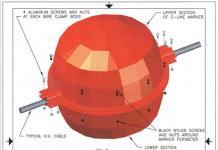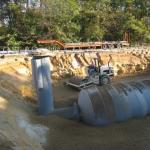The saying “my home is my castle” is true only during a well-fed, measured life. There is no way to escape truly serious dangers in your home. Stray bullets during a shootout between marauding gangs, air bombs, rockets, mortar shells and shells will pierce the walls. Those flying during a confrontation between regular armies will get you inside your home no worse than on the street. Therefore, it is better to wait out such bright events, as well as attacks by the living dead during a zombie apocalypse or an attack by aliens, in a more reliable place. Two characteristics are important here: strength and inconspicuousness. A compact, cozy bomb shelter, camouflaged in the garden or near your home, dug and furnished with your own hands, fits these parameters.
The bunker is convenient only because you won’t have to run far to get to it and a limited circle of people will know about it. The latter guarantees that, while escaping from shelling, you will not have to deal with uninvited guests who have come to get free supplies from your shelter. After all, driving out such guys, especially if they are armed, will not be easy.
Relevance of the problem
The possibility of an attack by aliens or zombies can only be considered as a joke or a plot for the next blockbuster. But local conflicts and wars, man-made disasters and natural disasters are the reality of our world. The history of mankind is the history of wars. Among all living beings on the planet, only man has made intraspecific killings a systemic and socially encouraged action. Therefore, one cannot think that the 21st century is very different from the enlightened 20th and all previous ones.
People also, with pleasure or forcedly, participate in hybrid and declared wars, interethnic conflicts and other activities to kill their own kind. If you do not want to become an accidental victim of such a “carnival,” make sure in advance that you have a durable bomb shelter. Otherwise, later, when everything starts, you will only have to rely on luck. Under the whistle of mines, perhaps there is a chance to dig a trench. But there is no way to build and equip your own bomb shelter according to all the rules.
In addition to military operations, it will help survive the consequences of a leak of a “peaceful atom” from a nearby (or distant) nuclear power plant or the achievements of the chemical industry that suddenly disperse into the air due to an accident of worn-out factory equipment.
At least, if a catastrophe does not occur and the end of the world does not come, you will become the happy owners of a wine cellar, from which you will not be kicked out by your wife and mother-in-law, or even by a company of soldiers.
Project Basics
An element that determines the reliability of a bunker is strong doors. They must withstand the shock wave. Therefore, the entrance design is designed for load resistance that is at least 1.5-2 times greater than required for normal floors according to SNiP.
To reduce the intensity of the shock wave approaching the doors, an expansion chamber must be provided in front of the entrance. Perhaps few people will be able to build a bomb shelter with doors like in the famous Fallout series. But, as they say, “do what is best, but it will turn out bad on its own.” Therefore, the exit from the bunker room to the expansion chamber must have a damper with two shutters. The cleanliness of the environment inside during air pollution during a chemical, bacteriological or nuclear attack depends on how tightly they close.
Another important entry requirement: there must be at least two of them. In this case, if the shock wave damages the doors or covers them with rubble, the shelter will not become a grave dug for you by yourself. And the calculation here should be made only on one’s own strength. In case of serious problems, you should not count on large rescue teams with dogs to search for victims and equipment to clear debris. There is an option that the situation will be simple: every man for himself.
The emergency exit must be located at least 20 centimeters above the groundwater level. If these standards cannot be met, the exit must be a sealed shaft protected from water penetration. Otherwise, building your own bomb shelters can only be compared to digging wells to irrigate a site.
The ventilation ducts of the bomb shelter are equipped with filters, and uninterruptible power supplies and generators are installed there to provide electricity. It is better to select alkaline batteries for UPS. They are distinguished by a particularly long “life span”. The generator exhaust system should not interface with the air in the shelter; it requires a separate ventilation duct and, preferably, a room. Otherwise, carbon monoxide will kill the bunker's inhabitants faster than shells or radiation.
Bureaucratic formalities
When you decide to make a bomb shelter on your own site with your own hands, you don’t need to deal with obtaining permits and coordinating the project with the mayor’s office or, God forbid, the military registration and enlistment office. The only thing you need to take care of is the safety of underground communications that may pass through your territory. During the construction of the shelter, not a single cable, water or gas pipeline should be damaged. Therefore, try to make sure that they are absent before construction begins.
The lack of formalities is fraught with another problem: it will not be possible to officially register the bunker as a yard building. Therefore, when selling a dacha or a house with a plot, problems with BTI representatives are possible. In this case, camouflaging the shelter will be no less useful than during an invasion by hordes of zombies or marauders. For the same reason, try not to advertise your construction site to your neighbors. In peacetime, they will be happy to “surrender” you to the BTI, and in wartime - to those who will benefit from doing so.
Groundwater
A swimming pool in a garden area is certainly a pleasant and useful addition. But this is only if we are not talking about an underground pool, which can turn into a bunker due to groundwater. Therefore, it is worth measuring their level before you start designing a bomb shelter on your own site.
There is no need to order georeconnaissance services. Just look at the depth of nearby wells. The distance from the surface of the earth to the water level is the very desired level. It can be determined more accurately by paying attention to water wells. Just don’t need to measure artesian wells for this: the depth of the water is necessary in an ordinary well “in the sand.” Don't have your own well or well? Ask your neighbors. But you shouldn’t explain to them why you really need it. Refer to the desire to build your own source of drinking water. By the way, if you are really concerned about survival issues, it will be very useful. As practice shows, the central water supply in cities often disappears much earlier than enemy bombs and shells begin to explode on their territory.
The shelter must be built so that it is located at least 50 centimeters above groundwater.
Important: sufficient strength of the room can be ensured by deepening it by at least 4 meters. If this cannot be done due to groundwater, all that remains is to build a shallow basement. Still, this is much better than trying to escape in a country house or in a cellar with pickles and potatoes.
Localization
One of the best options for bunker location is directly under the house. In this case, its main entrance will be securely hidden from prying eyes, which will provide additional security. Another extremely important advantage of this arrangement is that it makes it possible to hide in a bomb shelter during shelling. Running out of the house to take refuge in a shelter located even 15 meters from your home is not just unreasonable. This is suicidal. The walls of the house provide excellent protection from mine fragments and shrapnel, which are filled with multiple launch rocket systems. Therefore, if the shelling finds you not in a shelter, you need to lie down in the folds of the terrain, and not risk making your way under a hail of shrapnel.
So, having a bunker under your house is very nice. But if a shell hits, during an earthquake or hurricane, the building may collapse and the entrance to the bunker will be blocked. Emergency tunnels leading to the surface will be useful for this. Their exits must be located at a distance of no closer than 15 meters from ground buildings. Whatever happens, the equipment of your bomb shelter must ensure complete autonomy and independence from the communications of a residential building.
At the stage of calculating the location of the bunker, the issue of masking inputs and outputs should be finally resolved. You can make them in the form of an outdoor toilet, a light tool shed, a garage or even a doghouse. The latter can only be used to disguise an emergency exit. You will not be able to enter through it without attracting the attention of your neighbors.
Hopper size
The area of the shelter depends on its purpose and the number of people. For a short stay during a hurricane, 3 m2 per person is enough (9-12 “squares” per family). If you plan to live in it for some time, you will have to build a much larger room. You can make a preliminary layout, drawing or diagram to determine the location of the equipment and other nuances.
Short-stay shelter
To protect against natural disasters (not flooding, of course), a bunker made from a plastic septic tank is suitable. Its impact-resistant material will feel great in the ground. A preliminary design for such a structure is not even required. The price of a container with a volume of 18 cubic meters (which will give an area of 9 m2) is approximately 300 thousand rubles. You can do the ground work yourself or hire equipment. In the second case, the estimate will increase by another 50 thousand. No special engineering structures will be required. It is enough to make a simple ventilation system from two pipes with a dust filter made of gauze or fiberglass. For lighting and power supply, battery-powered flashlights and an uninterruptible power supply are sufficient. You can store a small supply of batteries there, which will be used in lighting and electrical appliances. Lamps should only be LED, since their energy consumption is 10 times lower than that of devices with incandescent coils.

You won't need a heater - the ground doesn't freeze at a depth of more than a meter, and you won't have to stay in such a bunker for long. It is better to pack thermal underwear, warm clothes and camping supplies.
Long-term shelter
If you expect to escape not only from bad weather, but from more serious and long-lasting disasters, you will have to start building a spacious bunker. In it you can wait out days of shelling, the consequences of an accident at a chemical plant, or the short-lived triumph of the aliens until Bruce Willis deals with them.
The size of such a bomb shelter should be noticeably larger than the septic tank proposed in the previous section. It should consist of “residential” and “technical” premises. The first needs to be equipped as much as possible for existence, the second should accommodate a generator and a dry closet.
After completing the layout of the shelter, you can proceed to earthworks. The dimensions of the pit must take into account allowances for the walls and foundation of the underground building. Until the brick walls are erected, the pit is reinforced with strong boards so that it does not become covered with earth while you reveal your talent as a mason.
The base of the foundation slab must first be laid with boards, the surface leveled and reinforced with 20 centimeters of crushed stone, and then the reinforcement must be laid. After pouring the base, it should be left alone for 10-15 days until it hardens and gains sufficient strength.

The walls of the shelter should be laid from durable solid bricks. Taking into account the high requirements for structural strength, reinforcement or metal mesh must be laid every three rows. This will not save you from a direct hit from an atomic bomb, but you can be sure that the bunker will not collapse on your head on its own. The walls are erected no lower than 2.2 meters.

The best material for the ceiling is a metal I-beam covered with boards and sheet metal. According to standards, the thickness of wood must be at least 40 mm, and steel panels - 5 mm. To prevent the structure from rotting and collapsing without any war, and to prevent water from pouring through the ceiling of the bunker after heavy rain, it is necessary to waterproof it. To do this, just put a couple of layers of plastic film. Earth is poured on top of it. The walls of the shelter are treated with waterproofing.
All that remains is to install a sealed hatch door and a ladder along which you can go down to your monastery. And don’t forget about the emergency exit, otherwise the shelter may turn into a spacious crypt.

The compartment for the dry closet and the electric generator is separated from the “living” space by a “half-brick” wall. The estimated cost of such a structure, if you build it yourself, starts at 100 thousand rubles.
Equipment and communications
To survive underground even for several days, natural ventilation alone is not enough. It is worth providing at least a fan, and better yet, an air conditioning and air purification system. This is already a serious application for successful survival in the event of major man-made and military disasters. But such pleasure costs no less than the entire homemade bomb shelter.
To keep it light and not boring, you need electricity. Naturally, it makes no sense to pull wires from the outlet into the bunker. Install lighting fixtures, a diesel or gasoline electric generator and stock up on at least one can of fuel.
Sanitary standards and the needs of the body determine the installation of a dry closet.
It is worth taking care of your rest by equipping bunk beds. This will save space.
Strategic reserves
First of all, drinking water is necessary for survival. Its norm per person is 2-3 liters. in a day. A family needs to stock up at least 300 liters. Long-lasting canned goods and cereals are also useful. The latter must be kept so that rodents and insects do not get to them before you do. It is optimal if you have the skills of drying and curing meat, in order, for example, to make a product such as pemmican (a briquette consisting of chopped dried meat, lard, spices and dried fruits), which can be stored for 6 months.
Be sure to prepare a first aid kit, including:
- antiseptics;
- antipyretics;
- painkillers;
- broad spectrum antibiotics;
- antidiarrhea medications;
- antiemetics;
- patch;
- bandage;
- gauze bandages;
- heating pad;
- scissors.
This list is expanding based on the health status of household members. It may include heart medications, insulin and other medications vital for chronic diseases.

In the bomb shelter you need to collect protective equipment for a reconnaissance sortie: a map, gas masks, OZK, flashlights. For the latter, you need to stock up on batteries.
Keeping ready
In order for the shelter to be “equipped to receive guests around the clock,” you will have to incur constant costs. It is necessary to monitor the expiration dates of food and water and replace expired ones with fresh products. You will have to do the same with medicines and batteries. It's not cheap, but keep in mind that any product, every pill or part will be worth its weight in gold if a serious problem occurs.
Now the topic of building a bomb shelter is not as relevant as many years ago, but still, in order to protect yourself from disasters, it is worth thinking about building such a room. A DIY nuclear bunker will help save lives and give you the opportunity to sit out in a safe place until the situation improves. A man-made accident or natural disaster remains a pressing reason for construction, from which no one is immune. Before building a bomb shelter, it is necessary to determine its intended purpose and the period of stay in it.
Construction of a bunker will not require any special documents. However, if centralized communications pass under the site, then problems may arise, so you need to find out this in advance.
Types of bunkers and requirements for bomb shelters
Nuclear bunkers must meet certain safety requirements:
- Protect people from damaging factors.
- Situate in an area that is not flooded.
- Have several entrances or exits, an emergency exit in case of failure of the main one.
- Purify the air from all kinds of harmful additives using ventilation equipment.
- Provide sanitary and hygienic conditions for people.
A bunker as a shelter for a family is classified according to:
- Protective properties.
- Location (built-in and free-standing).
- Filtration and ventilation support (industrial and handicraft production).
- Construction time (pre-built or pre-fabricated).
- Duration of stay (short and long term).
A short-term nuclear bunker is easy and quick to build. When building a simple shelter, energy and construction costs are saved several times. The bottom of the room is strengthened with stones or boards. A rational solution is to use a septic tank made of impact-resistant plastic, dug into the ground.
A nuclear bunker of this type will not require a serious heating system, since the concept does not provide for long-term stay. This design does not require complex engineering solutions. For a small room, natural ventilation is sufficient.
A preliminary drawing of the bunker will help you correctly formulate an action plan. This option is a simple solution that can be carried out at minimal cost.
Preparation for the construction of a bunker-bomb shelter
Nowadays, the construction of bunkers is rarely done, because the cost of construction is quite high. Therefore, if you have a plot of land, you can cope with this task yourself. To make a bomb shelter with your own hands, you need to invest in construction, purchase high-quality materials and other systems and structures to ensure safety and comfort. Before starting construction, you need to draw up an estimate, calculate construction costs and the cost of all necessary equipment.

Before construction begins, a diagram of the bunker is made and a location is selected. There are also a few things you should know factors, which are taken into account when constructing the premises:
- It is necessary to choose the right location for the bunker. There should be no pillars, bushes, trees or other structures nearby that could block the exit from the shelter in the event of a disaster.
- It is necessary to take into account the fact that the entrance to the premises is located as close as possible to the house, so that in case of an emergency you can immediately hide.
- Before starting construction of a bomb shelter, it is necessary to measure the groundwater level so that in the future it does not turn into a swimming pool. The depth of the pit should be half a meter above this level.
- It is important to measure the area correctly. The bunker diagram will help you calculate both its size and the number of square meters per person: for a short-term option, 3 m² per person is enough.
- It is strictly forbidden to build a bomb shelter with your own hands near gas and water supplies.
How to build a bunker? If you take into account the above factors, you can make your own bomb shelter that will last for many years.
How to build a long-stay bunker?
A family shelter is intended to provide shelter from various types of dangers and is most often located underground. The heaviest and most expensive thing is a foundation pit or concrete box. And the rest of the work can be done independently, but they must be done according to a certain sequence.

Construction will take much more time and effort. To build a reliable bunker with your own hands, you will need a huge amount of concrete. The most important thing is to well level the surface in the pit, and also strengthen its bottom with a 30 cm layer of crushed stone or sand. For better strength, you can use reinforcement and knitting wire.
It is important to foresee the location of the necessary communications, ventilation, emergency exit, and determine the power source. One thing is constant - the longer a person wants to stay in a bomb shelter, the more money will have to be invested in its construction and the purchase of the necessary elements.
Three main products for the construction of a long-stay bunker:
Step-by-step construction of a bunker with your own hands
A long-stay nuclear bunker is built according to the following stages:
- First, a pit is prepared, approximately 4 m deep, then wells are drilled. This is necessary so that the room does not depend on central heating.
- The sewage system of the bomb shelter is made at a level below the pit itself.
- An emergency exit is being thought through. A trench is dug from the pit, a pipe is laid there and filled with concrete.
- Two weeks after pouring concrete, when the foundation has hardened well, you can proceed to the construction of walls. During such work, it is worth remembering the laying of communications, water supply and sewage drainage.
- The issue of bunker arrangement is being resolved, energy supply and ventilation are taken into account.
- A roof is erected from floor slabs; dense polyethylene in two layers is used for waterproofing. If necessary, the bomb shelter is covered with earth.
- area – 12 m²;
- wall thickness – 25 cm;
- foundation slab thickness – 23 cm;
- Brick laying height is 2.2 m.
The long-term bunker type is suitable for those homeowners who take their safety more seriously. Here you can wait out not only bad weather, but also chemical attacks, and even a nuclear war.

The bunker drawing shapes the direction of the building. Next, the room is subject to a large amount of finishing work. Interior decoration, of course, is not so necessary and does not relate to safety. But before that, you should coat the floor and walls with waterproofing.
The completed bunker project will help you correctly calculate the openings for passage inside the room. The entrance is made of concrete rings or a metal tunnel, and the outside is covered with mastic for waterproofing.
Design of underground shelters- a reliable and sure way to preserve the life and health of your family. If you decide build a bunker with your own hands, there are various options for constructing underground structures.
It is necessary to dig a pit from 2 to 5 meters deep, cover the walls and floor with boards or logs. The upper ceiling is lined with polyethylene in several layers. Soil rock 30-5-0 centimeters thick is poured on top of the roof. You can use a wide pipe as an entrance/exit and build a hermetically sealed door. The bathroom is being built inside the shelter. It is necessary to equip your personal bunker with ventilation and a filtration device.
A concrete bunker is more reliable, but will require more financial costs. Construction depth is 10 meters. In order to enhance the safety of entry and exit from the outside, a small concrete structure is built at the zero level, using metal reinforcement, and a pressure door is installed. Or the entrance is built like a concrete shaft, taking into account the possibility of people of any size entering it. It is possible to use concrete rings.
It is known that thick reinforced concrete walls provide protection from radiation. For the same reason, a sealed door is also necessary at the entrance and exit directly to the shelter. For sheltering people and storing food, an internal room is used, in which a toilet is equipped. Reinforced concrete openings for ventilation are constructed at least three meters from each other. It must be remembered that such a shaft can serve as an emergency or additional exit.
Home, according to the saying, is a fortress, but there are misfortunes from which it is better to hide not in this fortress, but somewhere further away or, more precisely, deeper - for example, in your own family bunker. Especially for those who are afraid of natural disasters and generally take the issue of their own safety seriously, the RIA Real Estate website decided to prepare material on how to build a shelter on their own in a suburban area.
No bureaucracy required
First of all, experts note that to build a small shelter on your own site, you do not need to draw up special documents. However, this only works if there are no centralized communications running under the site, which could be damaged during the construction of the bunker. It is advisable to find out this before starting construction.
We measure the groundwater level
To prevent the construction of an underground bunker from turning into a pool of water, you need to know the depth of the groundwater. This, according to the chief architect, project manager of the company "Main Bureau of Architectural Solutions" Nikolai Matveev, can, in principle, be done on your own: just pay attention to the water level in nearby wells or pay attention to reservoirs or rivers that are nearby. The difference between the surface of the water, for example, in a well, and the surface level of the land plot will be an approximate indicator of the depth of groundwater.
You can also seek advice from neighbors who have their own water wells on their property, since when drilling them, the depth of groundwater is determined more accurately.
Of course, you need to build a bunker at least 50 centimeters above the groundwater level. For example, if groundwater in a site flows at a depth of 4 meters, then the depth of the pit should be no more than 3.5 meters, says Matveev. But the expert emphasizes that the ideal depth of a bunker is 4 meters, so in the case of closer groundwater, it is unlikely that it will be possible to build a good shelter, otherwise it will be uncomfortable, and therefore non-functional.
Location
It is important to choose the right place to build a bunker. Some homeowners prefer to install a bunker directly under the house, almost in the basement. But experts do not agree with this location. It is better to set up such a shelter at some distance from the house, since in the event of, for example, a strong hurricane or earthquake, the main building may be destroyed and its debris will block the exit from the bunker, notes Sergei Kudryavtsev, managing partner of PRIDEX.
Locating a shelter under a house is only possible if there are separate exits from it within a radius of 15 meters from the house structure, Matveev adds. In addition, communication systems must be autonomous and not connected in any way to home systems, he emphasizes.
Moreover, according to the expert, it is better to veil the entrance to the shelter. “For example, it can be placed on the side of a wooden outdoor toilet or tool shed. Typically, such structures are located in the garden among plants and trees, which makes penetration into the bunker most invisible to surrounding eyes,” says Matveev.
Taking measurements
Before you start building a bunker, you need to calculate its area. Considering that a shelter bunker in case of a hurricane or earthquake is not designed for long-term stay of people, you can limit yourself to 3 square meters per person, which will provide quite adequate conditions in case of danger. For an average family, the area of such a room will be 9-12 “squares,” says Kudryavtsev.
Short term bunker
If a bunker is being built exclusively for short-term stays, in case of natural disasters, then the most rational solution is to use a septic tank made of impact-resistant plastic dug into the ground, says Kudryavtsev. Such a solution will be quite sufficient to wait out a hurricane, but on the other hand, it is a durable structure that will not require significant funds to maintain it in proper condition, the expert argues.
Moreover, such a design does not require any complex engineering solutions, be it ventilation or heating. For a small shelter, natural ventilation is enough: essentially, these are two pipes leading to the surface, Kudryavtsev assures. Specialized air purification systems are also not needed for such a shelter. You can limit yourself to a standard dust-proof ventilation filter, which you can make yourself from gauze or fiberglass, notes the agency’s interlocutor.
Electricity supply, he said, may include connecting the facility to central networks and creating a reserve of batteries and accumulators for emergencies.
According to Kudryavtsev, it makes no sense to implement a serious heating system: the ground rarely freezes to a depth of more than 1 meter, while the shelter concept itself does not provide for long-term stay. “I think that in this case it makes sense to limit ourselves to a supply of warm clothes, thermal underwear and other hiking accessories,” the expert says.
“On average, a high-quality septic tank with a capacity of 18 cubic meters will cost about 300 thousand rubles. Whereas land work does not require special preparation, and it is quite possible to carry it out independently. If hired force is used, the cost of such work is unlikely to exceed 50 thousand rubles,” says PRIDEX Managing Partner.
Long stay bunker
For those homeowners who are serious about security issues and want to build a bunker in which they can hide for a long time not only from bad weather, but also from a chemical attack, Matveev advises building a bunker with an area of 12 square meters with a separate technical room of 2-3 square meters, where the energy generator and dry closet will be located.
The construction of a shelter begins with a pit, and when digging it, you need to take into account the thickness of the walls and the height of the foundation of the future bunker and, accordingly, make “allowances” for them. So, for example, the thickness of brick walls will be 25 centimeters, and the thickness of the foundation slab will be 23 centimeters. During the construction period, the walls of the pit must be reinforced with logs and boards in order to avoid collapse of the soil or soil.
Before pouring the foundation slab, it is necessary to prepare the foundation by leveling and strengthening the bottom of the pit with 20-30 centimeters of crushed stone or sand, Matveev instructs. To enhance the strength of the foundation, it is better to reinforce the foundation floor with reinforcement and binding wire. After pouring concrete, it is advisable to wait 10-15 days for it to harden and become durable, the expert emphasizes.
After the foundation has completely dried, you can begin building the walls. Matveev recommends using white solid brick with reinforcement of the masonry every 3 rows with metal mesh or wire. The thickness of the masonry can be half a brick. The height of the masonry must be at least 2.2 meters.
The next stage is the construction of the roof. The architect proposes to make the roof covering from a metal I-beam, covering it on top with boards 4 centimeters thick and sheets of metal 2 centimeters thick. For waterproofing the roof, according to Matveev, 2 layers of dense polyethylene are suitable. After this, the bunker is filled with earth. The entrance to the bunker is equipped with a tightly closing hermetic hatch door and a wooden ladder for descent. You can make a pressure door yourself by laying, for example, strips of insulation from a rubber tube. In addition to the main entrance, the bunker structure must also have an emergency exit in case the main manhole is blocked, the expert notes.
To waterproof the shelter from the inside, before finishing it is necessary to coat the walls and floor with waterproofing.
At the end, internal half-brick partitions are erected to create an engine room with a separate door.
The estimated cost of such a bunker, built with your own hands, will range from 75 to 130 thousand rubles, Matveev notes.
Engineering and household equipment
In order to survive in a bunker from 12 hours to several days, it is necessary to provide a source of autonomous power supply and an external ventilation duct with air filters to prevent toxic substances and dust from entering there. However, it is also possible to equip the bunker with an internal purification air conditioning system with air regeneration, but this will cost much more than conventional “external” ventilation, Matveev notes. The cost of such a system starts from 100 thousand rubles. However, this will be the only significant cost line for the construction of a shelter.
According to the architect, a generator running on gasoline or diesel fuel is suitable as an autonomous energy source system. Accordingly, the bunker should always have a canister with a supply of fuel for it, say, 10 liters.
To save space, the sleeping places in the bunker are arranged in the form of bunk beds.
Strategic reserve
The main strategic reserve in the bunker, according to Matveev, is water; it needs to be stored as much as possible - 200-300 liters. Food should be canned, and it’s also a good idea to stock up on various cereals - they are nutritious and have a long shelf life.
The first aid kit should include septic tanks, bandages, cotton wool, adhesive plasters, a thermometer, scissors, a rubber heating pad and gauze masks. Each family, in principle, can determine the set of medications independently, focusing on the health status of each member of the household, but it is better to include in the list heart medications, painkillers and drugs to normalize intestinal function.
Finally, in addition to warehouses with food and medicine, the bunker should have everything necessary to conduct “reconnaissance” forays to the surface. Such items include gas masks, protective clothing and a flashlight, Matveev adds.
Bomb shelter
Bomb shelter
To increase the safety of your loved ones and relatives, you can install armored sheets at the entrance to your house, alarms on the windows, hire security and take many other measures. But in the event of a nuclear war, only a bomb shelter designed like a bunker can protect. This could be a bomb shelter at the dacha, in which you can hide from natural disasters, fires or hurricanes, and also wait out any danger in cases where evacuation by other means is impossible.
Do-it-yourself shelters and underground bunkers on a summer cottage are quite legal, since there are no clear prohibitions. It is more difficult to make a bomb shelter with your own hands within the city, since the land plots are owned by the administration or other people. Let's take a closer look at how to build a bomb shelter with your own hands, where and how to find a place for it in the city, photos of typical shelters and bunkers in the house.
Your own bunker on the site can be used by private individuals as a place for a long stay or short-term stay. You can wait out some time in a simple cellar, although the bomb shelter does not contain complex schemes and resembles a cellar with a low earthen floor, walls made of boards or logs and a wooden roof.
There are also no drawings of a long-term bomb shelter, but there are some structural differences - it is necessary to drill wells, purchase and install a septic tank at the base of the pit. And only after this can a layer of concrete be poured as a foundation.
Each owner of the site found many advantages and disadvantages of both options, but they build bomb shelters in the country no deeper than half a meter to groundwater. It is recommended to have a thicker earthen lintel under your feet to prevent waterlogging of the base of the structure. Knowing his property, a person can clearly focus on the depth of groundwater, or check this point with neighbors with a drinking water well.
How to make a short-stay bomb shelter?
The most important thing when arranging bomb shelters is to choose the right place. The shelters made should not be placed under the house or near buildings, high landings or massive structures. The construction of a bomb shelter is carried out exclusively in places where there will be no rubble from destruction during disasters. A fence, a tree, a house - these buildings can collapse due to a shock wave or extreme elements, and the entrance will be blocked. Experts have found a way out - you need to make an emergency exit in case the main one collapses.
By simple calculations you can find out the amount of work in the ground that needs to be done. To hide from the elements for a short time, it is enough to dig three square meters. meters per person. With a building depth of 2 meters, a two-person bomb shelter will be 12 cubic meters. You can do this work yourself within a couple of weeks, maximum, a month.
The optimal location would be on a slope so that the sides of the entrance are covered with natural landscape. From the side, the entrance area is masked by technical buildings, a toilet or shed, large trees or powerful bushes.
View this post on Instagram
Interior arrangement
The floors in the pit are covered with sand and crushed stone, on top of which timber and deck boards are placed. Drainage must be sufficient to remove water from precipitation or melted snow. The walls made of earth need to be sheathed with logs (thin) or boards, and the ceiling should be finished with them. The cross members on the ceiling must be fastened especially carefully so that during a bombardment or from the action of a shock wave the soil does not destroy the roof when shaken.
The slope on top is covered with 20 centimeters of soil. An entrance is built on the side of the structure; it is better to make it a tunnel with a well made of earth and a lid. To minimize labor costs, you can bury a plastic septic tank, container or metal tank in the pit.
It is very important to make a ventilation system equipped with a pair of pipes. The longest one should be placed with an exit near the floor, and the second should be 20 cm near the ceiling. The exits are covered with deflectors, and they should rise no more than 40 centimeters. A dust filter is placed in each pipe; flax fiber or gauze is suitable for this. The bathrooms in the bomb shelter are fenced off and located near the hood so that the smell does not interfere with being inside. If you install a bio-toilet, the waste will be processed chemically.
A bunker or shelter in which people will stay for a long time, the pit must be dug 4 meters deep. The foundation is poured monolithic from 23 centimeters of concrete. The same work is performed during the construction of cottages or country houses. The concrete mixture needs to be strengthened with bundles of metal rods for reinforcement; basalt fiber rods can be used. You cannot do such work efficiently yourself, because the grant tends to sag and the foundation may become covered with cracks.
The area of the bomb shelter is determined based on the total area of the residential sectors of 12 square meters, but a toilet, shower and technical sector are equipped separately. One room can be made into a warehouse for food and things. You can also store drinking water in your food pantry. The walls must be 2.2 meters and at least 0.25 meters thick. The connection to the base must be monolithic, without cracks or seams. The optimal material would be concrete.
The ceiling is made of slabs filled with a cap and a layer of soil. Channels can be used to strengthen the floors; the main exit is arranged like a pipe in a trench. It is installed on slopes, making the shelter more protected. The exit can serve as ventilation, especially if it is reinforced with a half-meter corrugated pipe. A special booth is made on the surface into which the end of the corrugated sleeve is inserted.
Bunker house project
Much attention is paid to the entrance - it is hidden from prying eyes and has a hermetically sealed closure. Water and electricity are supplied to the building, and wastewater is discharged. It is necessary to prepare in advance a supply of medicines and food, water and other necessary things, without which the owner will feel uncomfortable.
An air-raid shelter is built according to a person’s individual plans, but there are also ready-made drawings in which you can make changes and add rooms. Experts recommend studying additional information and reading literature on arranging shelters in order to, if necessary, equip a library or recreation area, gym and other sections inside.





















